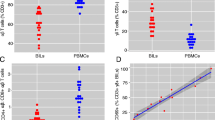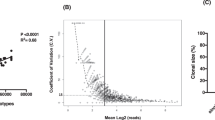Abstract
Background
Interactions between γδ T cells and heat shock proteins (HSP) have been proposed as contributing factors in a number of diseases of possible autoimmune etiology but definitive evidence to support this hypothesis has been lacking. In multiple sclerosis (MS), a chronic inflammatory neurologic disease, HSP and γδ T cells are known to colocalize in brain lesions. Analysis of T cell receptor (TCR) gene usage in these lesions has detected evidence of clonality within both the Vδ2-Jδ1 and Vδ2-Jδ3 populations of γδ T cells. In our own studies, using direct sequence analysis, a dominant Vδ2-Jδ3 TCR sequence was found in 9 MS brain samples, suggesting a response to a common antigen. In this report, we have examined γδ T cell receptor gene usage in MS peripheral blood T cell lines selected for reactivity to HSP 70.
Materials and Methods
TCR rearrangement patterns for Vδ2-Jδ1 and Vδ2-Jδ3 were studied using the polymerase chain reaction (PCR) and a direct sequencing technique in populations of peripheral blood mononuclear cells (PBMC) cultured with Mycobacterium tuberculosis (M. tuberculosis) purified protein derivative (PPD) and then selected for reactivity to a 70-kD heat shock protein (HSP70). Cells were obtained from healthy donors, patients with MS, and patients with tuberculosis (TB). PCR products were subjected to direct sequence analysis to look for evidence of clonality within these T cell lines and to define the sequence of the V-D-J (CDR3) region of the TCR.
Results
In freshly isolated PBMC, both Vδ2-Jδ1 and Vδ2-Jδ3 gene rearrangement patterns were detected, whereas in HSP70+ T cell lines the predominant δ chain rearrangement pattern was Vδ2-Jδ3. Direct sequence analyses indicated that in cells reactive with HSP70 the Vδ2-Jδ3 sequences were usually oligoclonal and used Dδ3 exclusively. In four of four MS and two of three TB patients, the oligoclonal sequences in the HSP70+ T cell lines were identical to one another and to a dominant sequence previously detected in MS brain lesions. In two of three HSP70+ T cell lines from healthy controls, the oligoclonal sequences differed from those found in both groups of patients but were identical to one another except for a small region of heterogeneity in the second N region. In contrast, in freshly isolated PBMC or in PPD+HSP70− T cell lines, the Vδ2-Jδ3 gene rearrangement patterns were usually polyclonal and dominant sequences were rarely identified.
Conclusions
These results support the conclusion that a subpopulation of γδ T cells in MS lesions are responding to HSP 70 and that non-CNS-specific antigens contribute to the pathogenesis of MS.


Similar content being viewed by others

References
Georgopoulos C, McFarland H. (1993) Heat shock proteins in multiple sclerosis and other autoimmune diseases. Immunol Today 14: 373–375.
Porcelli S, Brenner MR, Band H. (1991) Biology of the human γδ T-cell receptor. Immunol Rev. 120: 137–183.
Haas W, Pereira P, Tonegawa S. (1993) Gamma/delta T cells. Annu. Rev. Immunol 11: 637–685.
De Libero G, Casorati G, Giachino C, et al. (1991) Selection by two powerful antigens may account for the presence of the major population of human peripheral gamma-delta T cells. J. Exp. Med. 173: 1311–1322.
Parker CM, Groh V, Band H, et al. (1990) Evidence for extrathymic changes in the T cell receptor γδ repertoire. J. Exp. Med. 171: 1597–1612.
Modlin RL, Pirmez C, Hofman FM, et al. (1989) Lymphocytes bearing antigen-specific γδ T-cell receptors accumulate in human infectious disease lesions. Nature 338: 544–548.
Janis EM, Kaufman SHE, Schwartz RH, Pardoll DM. (1989) Activation of γδ T cells in the primary immune response to Mycobacterium tuberculosis. Science 244: 713–716.
Kabelitz D, Bender A, Prospero T, Wesselborg S, Jannsen O, Pechhold K. (1991) The primary response of human γδ+ T cells to Mycobacterium tuberculosis is restricted to Vγ9 bearing cells. J. Exp. Med. 173: 1331–1338.
Haregewoin A, Soman G, Hom RC, Finberg RW. (1989) Human γδ T cells respond to mycobacterial heat shock protein. Nature 340: 309–312.
O’Brien RL, Happ MP, Dallas A, Palmer E, Kubo R, Born WK. (1989) Stimulation of a major subset of lymphocytes expressing T cell receptor gamma delta by an antigen derived from Mycobacterium tuberculosis. Cell 57: 667–674.
Ohmen J, Barnes PF, Uyemura K, Lu S, Grisso CL, Modlin RL. (1991) The T cell receptors of human γδ T cells reactive to Mycobacterium tuberculosis are encoded by specific V genes but diverse V-J junctions. J. Immunol. 147: 3353–3359.
Pfeffer K, Schoel B, Plesnila N, et al. (1992) A lectin-binding, protease-resistant, mycobacterial ligand specifically activates Vγ9+ human γδ T cells. J. Immunol. 148: 575–583.
Tanaka Y, Sano S, Nieves E, et al. (1994) Non-peptide ligands for γδ T cells. Proc. Natl. Acad. Sci. U.S.A. 91: 8175–8179.
Rajasekar R, Sim G-K, Augustin A. (1990) Self heat shock and γδ T cell reactivity. Proc. Natl. Acad. Sci. U.S.A. 87: 1767–1771.
Birnbaum G, Kotilinek L, Albrecht L. (1993) Spinal fluid lymphocytes from a subgroup of multiple sclerosis patients respond to mycobacterial antigens. Ann. Neurol. 34: 18–24.
Salvetti M, Buttinelli C, Ristori G, et al. (1992) T lymphocyte reactivity to the mycobacterial 65- and 70-kDa heat shock proteins in multiple sclerosis. J. Autoimmun. 5: 691–702.
Salvetti M, Ristori G, Buttinelli C, et al. (1994) T Lymphocyte response to 70-kD heat shock proteins in multiple sclerosis, in tuberculosis and in healthy individuals. J. Neuroimmunol. 54: 193A.
Stinissen P, Vandevyer C, Medaer R, et al. (1995) Increased frequency of γδ T cells in CSF and peripheral blood of MS patients: Reactivity, cytotoxicity and T cell receptor V gene rearrangements. J. Immunol. 154: 4883–4894.
van Noort JM, van Sechel AC, El Ouagmiri M, Bajramovic J, Polman CH, Ravid R. (1994) A small heat shock protein serves as immunodominant T-cell antigen in MS-affected human myelin. J. Neuroimmunol. 54: 194A.
Selmaj K, Brosnan CF, Raine CS. (1991) Co-localization of lymphocytes bearing γδ T-cell receptor and heat shock protein hsp65+ oligodendrocytes in multiple sclerosis. Proc. Natl. Acad. Sci. U.S.A. 88: 6452–6456.
Wucherpfennig KW, Newcombe J, Li H, Keddy C, Cuzner ML, Hafler DA. (1992) γδ T-cell receptor repertoire in acute multiple sclerosis lesions. Proc. Natl. Acad. Sci. U.S.A. 89: 4588–4592.
Shimonkevitz R, Colburn C, Burnham JA, Murray RS, Kotzin BL. (1993) Clonal expansion of activated γ/δ T cells in recent onset multiple sclerosis. Proc. Natl. Acad. Sci. U.S.A. 90: 923–927.
Hvas J, Oksenberg JR, Fernando R, Steinman L, Bernard CCA. (1993) γδ T cell receptor repertoire in brain lesions of patients with multiple sclerosis. J. Neuroimmunol. 46: 225–234.
Battistini L, Selmaj K, Kowal C, et al. (1995) Multiple sclerosis: Limited diversity of the Vδ2-Jδ3 T-cell receptor in chronic active lesions. Ann. Neurol. 37: 198–203.
Triebel F, Faure F, Mami-Chouaib F, et al. (1988) A novel Vδ gene expressed predominantly in the TiγA fraction of γ/δ+ peripheral lymphocytes. Eur. J. Immunol. 18: 2021–2027.
Davodeau F, Peyrat MA, Hallet MM, Houde I, Vie H, Bonneville M. (1993) Peripheral selection of antigen receptor junctional features in a major human γδ subset. Eur. J. Immunol. 23: 804–808.
Breit TM, Wolvers-Tettero ILM, van Dongen JM. (1994) Unique selection determinant in polyclonal Vδ2-Jδ1 junctional regions of human peripheral γδ T lymphocytes. J. Immunol 152: 2860–2864.
Wucherpfennig KW, Liao YJ, Prendergast M, Prendergast J, Hafler DA, Strominger JL. (1993) Human fetal liver γδ T cells predominantly use unusual rearrangements of the T cell receptor δ and γ loci expressed on both CD4+ and CD8− and CD4−CD8− γδ T cells. J. Exp. Med. 177: 425–432.
Uyemura K, Klotz J, Pirmez C, et al. (1992) Microanatomic clonality of γδ T cells in human Leishmaniasis lesions. J. Immunol. 148: 1205–1211.
Robijn RJ, Bloemendal H, Jainandunsing S, et al. (1993) Phenotypic and molecular characteristics of human monoclonal TCRγδ T cell-lines from jejunum and colon of healthy individuals. Scand. J. Immunol. 38: 247–253.
Orsini DLM, van Gils M, Kooy YMC, et al. (1994) Functional and molecular characterization of B cell-responsive Vδ1 + γδ T cells. Eur. J. Immunol 24: 3199–3204.
Tamura N, Holroyd KJ, Banks T, Kirby M, Okayama H, Crystal RG. (1990) Diversity in junctional sequences associated with the common human Vδ9 and Vδ2 gene segments in normal blood and lung compared with the limited diversity in a granulomatous disease. J. Exp. Med. 172: 169–181.
Uyemura K, Deans RJ, Band H, et al. (1991) Evidence for clonal selection of γ/δ T cells in response to a human pathogen. J. Exp. Med. 174: 683–692.
Olive C, Gatenby PA, Serjeantson S. (1992) Variable gene usage of T cell receptor γ and δ-chain transcripts expressed in synovia and peripheral blood of patients with rheumatoid arthritis. Clin. Exp. Immuol. 87: 172–177.
Pluschke G, Ruegg D, Hohlfeld R, Engel AG. (1992) Autoaggressive myocytotoxic T lymphocytes expressing an unusual gamma/delta T cell receptor. J. Exp. Med. 176: 1785–1789.
Giachino C, Granziero L, Modena V, et al. (1994) Clonal expansion of Vδ1+ and Vδ2+ cells increase with age and limit the repertoire of human γδ T cells. Eur. J. Immunol 24: 1914–1918.
Freedman MS, Ruijs TCG, Selin LK, Antel JP. (1991) Peripheral blood gamma-delta T cells lyse fresh human brain-derived oligodendrocytes. Ann. Neurol. 30: 794–800.
Janeway CA, Jones B, Hayday A. (1988) Specificity and function of T cells bearing γ/δ receptors. Immunol. Today 9: 73–76.
D’Souza SD, Antel JP, Freedman MS. (1994) Cytokine induction of heat shock protein expression in human oligodendrocytes: An interleukin-1-mediated mechanism. J. Neuroimmunol 50: 17–24.
Freedman MS, Abiscott J, Goldstein R. HSP70 gene polymorphism correlates with cellular reactivity to HSP in multiple sclerosis. Neurology (1995) 45: A467.
Acknowledgments
Supported in part by USPHS Grants NS 11920 and NS 08952, and RG 1001-H-8 and FA 1095 from the National Multiple Sclerosis Society, the New York Community Trust and the Gladstein Foundation; and by grants from the Italian Multiple Sclerosis Society (AISM) and the Istituto Mediterraneo per la Ricerca Scientifica, Pozzilli, Italy. Presented in part at the IVth International Congress of Neuroimmunology, Amsterdam, The Netherlands, 1994.
Author information
Authors and Affiliations
Rights and permissions
About this article
Cite this article
Battistini, L., Salvetti, M., Ristori, G. et al. γδ T Cell Receptor Analysis Supports a Role for HSP 70 Selection of Lymphocytes in Multiple Sclerosis Lesions. Mol Med 1, 554–562 (1995). https://doi.org/10.1007/BF03401592
Published:
Issue Date:
DOI: https://doi.org/10.1007/BF03401592



